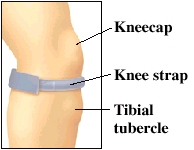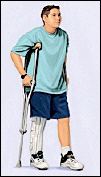Treating Osgood-Schlatter Disease
When to Call the Doctor
After a few weeks of self-care, your knee should feel better. But let your doctor know if the pain gets worse or if it doesn't go away with rest.
How soon your knee gets better is up to you. Resting and icing it, and perhaps wearing a special knee strap, will help you heal.

Giving Your Knee a Rest
When it comes to how much you should rest the knee, let pain be your guide. If you feel a lot of pain, stay off the knee as much as you can. Avoid jumping, walking up or down stairs, or doing activities that cause pain. If your pain is mild, try swimming or other sports that don't put as much stress on the knee. As the pain lessens, ease into your normal routine.
Reducing Pain and Swelling
If the pain and swelling really bother you, try icing your knee for 10 to 15 minutes a few times a day. Also, over-the-counter medicine may help reduce swelling. Be sure to first ask your doctor what kind of medicine to take. Medicine that contains aspirin can cause complications if you have some other illnesses. Your doctor can give you the details.

Wearing a Knee Strap
Your doctor may give you a special knee strap to wear. It can relieve some of the pressure on your knee. You can wear it when playing sports and even when just walking around. Wear the strap right below your kneecap but above the bump formed by the tibial tubercle.

A brace or a cast may be used to help your knee heal.
If Your Problem Is Severe
Sometimes, resting your knee isn't enough to make it better. You may need further medical treatment. Immobilization is treatment that keeps you from moving the knee. You may wear a brace or a cast for a few weeks. During that time, you'll walk with crutches. Later, you'll need to regain flexibility and strength in your knees and legs. You can then ease into your normal routine. But if your knee hurts, rest it until you feel better.








